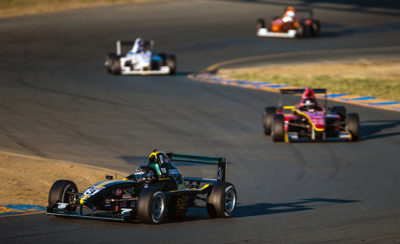As the 2018 season draws to a close, it’s expected that many FE owners will convert to the new engine spec for 2019
The original Formula Enterprises car was a Van Diemen chassis designed for a European spec series. SCCA Enterprises mated it with a 2.3-liter engine that was a joint product of Mazda and Ford, along with an Elite transmission, and created a solid spec formula car that has now been raced for 15 years. But that 2.3-liter engine is no longer produced and supported, so it became time for a replacement. Enter the engine that powers a huge number of spec series, the MZR, and a new class, Formula Enterprises 2.
“We had to do something before we got to the point where we couldn’t provide service,” explains SCCA Enterprises President Robey Clark. “So we started looking into it a couple of years ago, talking with Mazda. We decided on the 2.0-liter MZR motor, which is something Mazda has in their motorsports program and will support now for many years to come. It is basically the same architecture as the 2.3, so it’s a fairly easy update to the car.”
At the same time, the parties involved saw an opportunity to upgrade the transmission as well. The Elite transmission in the car was designed around 140hp; the 2.3-liter engine produced 170, so the transmission was a weak link. A new SADEV sequential gearbox fit the bill, and that transmission is legal in both Formula Enterprises and Formula Enterprises 2. The two classes will co-exist in SCCA’s national level for one more season; after 2019, the 2.3-liter will only be eligible for SCCA regional competition. So far, Enterprises has sold more SADEV transmissions than 2.0-liter engines, but Clark says he expects that to change now that the Runoffs has passed.
The difference in FE and FE2 is striking – Flinn Lazier set the pole time for FE2 at the 2018 SCCA National Championship Runoffs at nearly 1:35 flat; Mark Snyder was the polesitter in FE, about 2.5sec slower around Sonoma Raceway.
“Our mission was to make sure the 2.0-liter car was a higher-performing car than the 2.3; we needed to step it up a little bit,” says Clark. “For most tracks, 3.5- to 4-mile long, it’s two-and-a-half to three seconds faster. It’s a higher revving motor so it sounds good; it sounds like a race motor. Everything feels better and faster. The SADEV transmission, a six-speed sequential with no-lift shift, was also a big upgrade for the class.”
Clark also reports that SCCA Enterprises has acquired all the tooling for the chassis and body and will start building new cars sometime in the next couple of years. A new chassis hasn’t been built since 2012, and Clark says Enterprises only has two of the English-built chassis left.
Converting existing cars to fit the MZR and new transmission is a relatively clear-cut process; Clark says someone with experience could do it in about 20 hours. Kevin Kloepfer of Comprent Motor Sports says it’s about a day-and-a-half job, very straightforward and it comes with everything. Clark says the SADEV has a custom housing so that the suspension mounting points remained the same. The conversion is not cheap, however – the transmission is $10,000 and the 2.0-liter engine kit is $9,500. But the SADEV, he says, should have no reliability problems.
Clark estimates that there are about 50 to 60 FE/FE2 cars being actively campaigned. He says that there are 60 other chassis in shops and garages. He’s hoping that the new package will draw the additional 60 cars back to the track or encourage owners to sell them to someone interested in the car with the upgraded engine and transmission.
“We’d love for more cars to come out and race,” Clark says. “I can’t forecast if we’re going to get a bunch more, but we’re hoping that in 2019 we will have more than 40 FE2s on the track that are actually racing. I would hope to have, sometime in 2020, 80 cars racing on a regular basis. That’s a big percentage jump, to basically double, but that’s the goal.”


 ACCESSIBILITY
ACCESSIBILITY